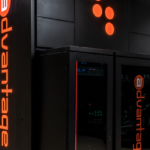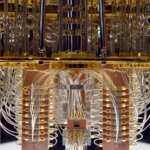Jellybean QDs add appeal to quantum computing on silicon
|
Getting your Trinity Audio player ready...
|
• Elongated jellybean quantum dots give chip designers more options
• Quantum computing on silicon leverages ready-made scale-up path
• Cloud services offer developers an introduction to quantum tools
The industrial appeal of quantum computing is growing as early quantum computing systems are being made available to consumers in the cloud. And startups such as Horizon Quantum Computing and Algorithmiq – both part of the recently formed Trinity Quantum Alliance, which also includes Microsoft, IBM, and Moody’s Analytics – are making programming quantum applications more intuitive for users. But to achieve their full potential, systems will need to be scaled up beyond the tens and hundreds of quantum bits (qubits) comprising current designs. And quantum computing on silicon allows developers to use conventional chip-making tools, which provides a ready-made path to commercialization.
The delicate nature of qubits means that they can be easily affected by their surroundings. Systems are noisy and error correction schemes are critical to generating meaningful results. Having thousands rather than hundreds of physical qubits would provide many more logical qubits to run powerful algorithms that, in theory, set quantum computers apart from classical machines. And practical evidence from teams such as Google Quantum AI shows signs of so-called quantum supremacy – the ability to solve problems beyond the reach of conventional supercomputers.
Much is made of the ability of qubits to be in multiple states at the same time – a phenomenon known as superposition – when looking at what makes quantum computing on silicon and other platforms so impressive. The behavior allows qubits, which carry a probability of being either 1 or 0, to consider more information in comparison with classical bits. In fact, the amount of classical information contained by N qubits scales according to 2N, and this exponential advantage is one of the reasons why quantum computing is so highly prized.
Physics at work
There’s another dimension to reflect on too, and that’s the ability of quantum computers to consider all solutions at the same time, rather than having to step through different answers to a problem sequentially. Quantum systems reframe mathematical questions as physics problems, which allows behavior such as interference to be included in the toolbox. Allowing qubits to constructively and destructively interfere with each other can be exploited to amplify the most likely solution to a problem above other outcomes.
And these features make quantum computers particularly useful at solving optimization problems. For example, if you are trying to find the most direct path out of a maze, a quantum algorithm will output all options at once, with the distribution popularizing the most favourable answer – in this case, the shortest route. More practically for industrial clients, it’s widely believed that quantum algorithms will accelerate the search for advanced materials and novel pharmaceutical structures. Systems could also rapidly solve complex logistical problems.
But while the computational benefits of quantum interference are clear to see – noting the security concerns that may arise if systems succeed in breaking classical encryption schemes – leveraging this performance presents a challenge when it comes to building chips. Qubits need to be close to each other for their logic to work, very close. If they are spaced more than just a few nanometres apart, the control of one qubit is no longer conditional on the state of the other.
Adding to the issue, is the need for quantum chip designers to add wires to their layouts to help configure the qubits and enable readout of results. And now things are starting to look mighty cramped. The good news for teams creating quantum computing on silicon is that jellybean geometries could reduce some of that pressure to sit everything so close together.
Jellybean geometry
Typically on such platforms, qubits are engineered using quantum dots (QDs) that recruit single electrons from a silicon pool of subatomic particles, which are then held by quantum gates. Programmed using microwaves, the electrons can be set as spin up or spin down – using their magnetic states to represent the zeroes and ones. And it turns out that if these QDs are elongated – rather than being round – the electrons can chain information together, and qubits can be slightly more widely spaced.
“The small size and excellent integrability of silicon metal–oxide–semiconductor (SiMOS) quantum dot spin qubits make them an attractive system for mass-manufacturable, scaled-up quantum processors,” write the researchers in their paper, published this month in Advanced Materials. “At high electron occupancies, these dots merge into one large dot with well-defined spin states, verifying that jellybean dots have the potential to be used as qubit couplers in future quantum computing architectures.”
Quantum computing has been decades in the making, and the observation represents another step forward in realizing practical designs capable of being scaled up using industrial tools that have already proven effective in supporting the production of conventional chips. It’s no surprise that Intel, which has a rich history in producing classical computer processors, is looking to use its silicon know-how to create commercial qubit wafers. And these breakthroughs, coupled with abstracting the programming complexities behind higher-level libraries, is making quantum computing a more practical proposition.
Interest from developers in getting ‘hands-on’ with systems is on the up. IBM has been making its quantum computers available over the cloud since May 2016, and subscribers to those services have configured huge numbers of quantum circuits – sets of programming instructions realized through quantum logic gate building blocks – using its tools. And that’s just one provider. Today, there are many more quantum solutions available online, and it highlights the direction of travel for quantum computing on silicon, as well as other platforms that include superconducting loops, trapped ions, and other architectures.










